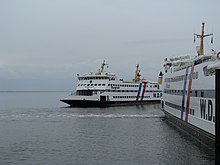Rungholt (ship, 1992)
|
The Rungholt after leaving Wyk
|
||||||||||||||||||||||||||
|
||||||||||||||||||||||||||
|
||||||||||||||||||||||||||
|
||||||||||||||||||||||||||
|
||||||||||||||||||||||||||
|
||||||||||||||||||||||||||
The Rungholt is a former car and passenger ferry operated by Wyker Dampfschiffs-Reederei Föhr-Amrum GmbH .
history
The Rungholt was built under construction number 1520 at the Husumer Schiffswerft GmbH in Husum . The keel was laid on August 19, 1991, the launch on April 10, 1992. The test drive took place on May 29 of the same year. Since then, the ferry has connected the islands of Föhr and Amrum with the mainland port of Dagebüll . The namesake is the town of Rungholt, which is sunk in the North Sea . The Rungholt is the sister ship of the Nordfriesland built in 1995 .
On May 4, 2018, the Rungholt was used for the last time between Föhr, Amrum and Dagebüll; it was replaced by the new Norderaue building. Since then, the Rungholt was launched and served as a replacement ferry if necessary. On October 17, 2019, she was sold to the Greek company Cretan Daily Cruises . The new owner will transfer the ship to Piraeus under Greek registration in the Mediterranean . Modifications are planned there in order to use the ship as Nissos Chrissi for day trips.
particularities
Due to the ever-widening passenger car, the Rungholt was two meters tall with otherwise similar dimensions compared to other ferries operated by Wyker Dampfschiffs-Reederei Föhr-Amrum - North Friesland (built in 1978), Uthlande (built in 1980) and Schleswig-Holstein (built in 1988) wider. Thus, a generation change was heralded for the ferries, which had hardly changed visually since 1972, when Schleswig-Holstein was built .
Visible changes:
- The ship has eight windows at the front in the saloon deck (all older types have five windows).
- The smoke gas posts are located one deck higher, i.e. on the sun deck.
- Instead of the usual stern doors (sliding doors) on the car deck, the ship is also equipped with a hydraulically operated rear visor.
Technical specifications
The ship is powered by two MaK - diesel driven type 6M332C with a total of 1,920 kW. The motors act via reduction gears on two controllable pitch propellers in Kort nozzles . The ship is equipped with an electrically powered bow thruster . Five diesel generators are available on board to generate electricity.
Others
A ferry of the same name , but much smaller, runs between the Halligen and the mainland port of Schlüttsiel .
Web links
Individual evidence
- ↑ New ferry on the Föhr-Amrum line crosses the Kiel Canal. Der Insel-Bote , April 29, 2018, accessed on April 29, 2018 .
- ↑ Baptism of the Norderaue postponed again. The Insel-Bote, March 27, 2018, accessed on April 3, 2018 .
- ↑ WDR sells Rungholt to Greece. Hansa - International Maritime Journal , October 18, 2019, accessed October 19, 2019 .
- ^ WDR's Rungholt sold to Blue Cruises. ferryshippingnews.com of October 24, 2019, accessed October 27, 2019


